 |
The Saint of the Day
St. John Nepomucene - May 16
Prof. Plinio Corrêa de Oliveira
Biographical selection:
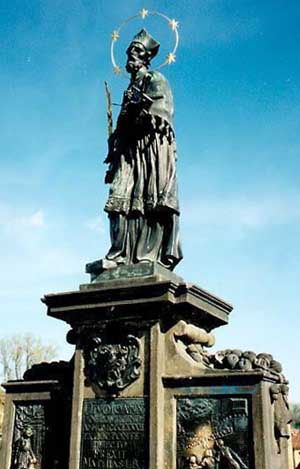
A statue of St. John Nepomucene stands on Charles Bridge in Prague
|
When John was born in 1330 in Nepomuk, Bohemia, extraordinary lights were seen over his house. When he was a child, the Holy Virgin Mary cured him of a grave illness. After he was ordained a priest he dedicated himself to preaching, with great success. The whole city of Prague changed its customs because of his sermons, which were listened to by multitudes. To this day he is the most popular saint of Prague.
Wenceslas IV, King of Bohemia and Emperor of Germany, named him provost of Witchad and gave him the title of chancellor of the Kingdom, but John refused these honors to remain a regular canon. The Empress chose him as her confessor.
King Wenceslas went astray and became a tyrant over his people. He was very jealous and suspicious of the Empress, who used to spend hours in the Church praying for his conversion. Imagining bad things about her, the King called St. John Nepomucene and ordered him to reveal what his wife had told him in confession. The Saint refused.
This happened several times. Nothing could make St. John reveal the secret of confession. After torturing him and putting him in prison several times, the King was forced to free him because he feared a public revolt, given the popularity of the Saint. The King even threatened him with death, but St. John Nepomucene remained firm in his position.
One day, feeling that his end was near, he gave a sermon on these words of Our Lord: "Yet a little while, and you will see Me no more." He predicted the devastation that the heresy of John Hus would cause in Bohemia. Then, he went to pray at the feet of the statue of Our Lady that had been brought to the region by St. Cyril and St. Methodius.
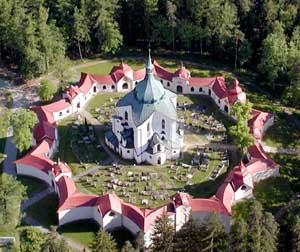
A Chapel in honor of St. John of Nepomucene outside Prague, surrounded by a star-shaped wall to commemorate the miracle after his death
|
Returning to Prague he was taken by agents of Wenceslas and again threatened. He remained constant: when he was tortured again, he refused to break the secrecy of confession. Finally the King ordered that he be cast into the river and drowned. That night his hands and feet were bound, and he was thrown from the Charles Bridge of Prague into the Moldau River.
When his body hit the water, five stars appeared over the spot. The people of Prague came in great numbers to witness the marvel. The Empress pointed out the miracle to the King, who became terrified and closed himself in his room for several days.
St. John Nepomucene became a special Patron Saint of the more illustrious families of Germany. In gratitude for the many graces received from St. John Nepomucene, the House of Austria offered whatever assistance it could in the process for his canonization. He was raised to the altars in 1729.
Ten years before, in 1719, his body was found intact in the Moldau River, as if it had been thrown into it minutes before. When his shrine was opened many years later, his tongue remained incorrupt, which for its silence, gave such a great glory to God.
Comments of Prof. Plinio:
This is a very beautiful biography. To place it in its historical context, we should recall the historical conditions of Europe at that time.
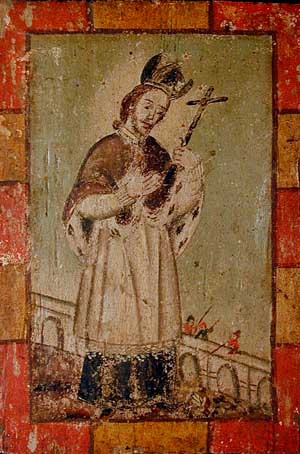
A 19th century Mexican retablo of St. John Nepomucene, Patron Saint of Confessors
|
Those regions of Central Europe often rebelled against the Catholic influence. Bohemia, Moravia, and other neighboring regions were lands of witchcraft and occultism where heresies of all kinds were born. In that epoch when the Middle Age was starting to decline from its apogee, a heresy took root in that region: The heresy of John Hus, the famous heresiarch who was a precursor of Luther.
This heresy of Hus was both similar to and different from that of Protestantism.
Let me address the similarity. A heresy, at least a heresy that achieves a certain success, is never just the product of a single individual's mind, but rather it results from a whole environment. The heresiarch produces a doctrine that those in his region are eager to receive. The heresy goes forward because a part of the public is receptive to it. The foolish heresiarch elaborates a doctrine that is not accepted by those around him. He is rejected and his name is not recorded by History. He goes to Hell alone. But the shrewd heretic prepares a doctrine that corresponds to the bad tendencies of the environment in which he lives. This is why his doctrine spreads.
John Hus perceived that pride and sensuality inclined the souls of his region toward the doctrine he elaborated. Luther took up the doctrine of Hus because the same decadence existed in the Germany of his time. One thing for which Emperor Charles V stands responsible is that he did not take the strong stand against Luther that his predecessors did against Hus. On certain occasions, the only solution is to extirpate the evil at its root.
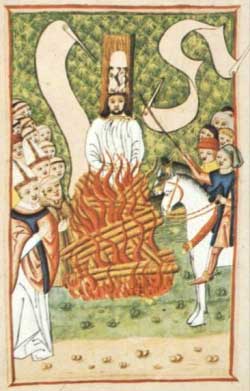
John Hus condemned by the Council of Constance & burned at the stake
|
St. John of Nepomucene was living in that epoch when the region was moving from Catholicism to the heresy of Hus. In the beginning of his public mission, he was well considered by the King of Bohemia, who supported him. But, influenced by the bad forces in the region, the King deteriorated and became a bad man. The Queen, however, remained good. Since she used to spent long periods of times in the Church, the King imagined that this was a pretense to commit adultery. Hence his insistence with St. John Nepomucene to reveal what she had told him in confession.
You know that the seal of confession is sacred. Never, for any reason or under any circumstance can a priest reveal anything that he heard under the seal of confession. He cannot even say that a man who is being accused unjustly is innocent: Revealing anything is forbidden. It is a complete secret.
So the King began to persecute the Queen's confessor. He tortured St. John several times, threw him in prison, but the Saint refused to say anything. Then the King, who had been elected Emperor of the Holy Empire, decided to kill the Saint.
The latter had a divine premonition of his martyrdom and prepared himself to die. From the pulpit he commented on those beautiful words of Our Lord: "Yet a little while, and you will see Me no more." It was his way to warn the people that he would die. Afterwards, being a great devotee of Our Lady, he went to a village where the first statue of Our Lady had been brought to the country by St. Cyril and St. Methodius, the two Saints who evangelized the Slavic world. Then he returned to Prague, where he was taken by the King, who ordered him to be drowned in Moldau River.
When he was thrown into the river, a great marvel occurred. Five stars emerged from the waters over the place where he had submerged, clearly a miracle. The Queen called her husband to see it so he could realize the crime he had committed. Seeing this miracle, he became disturbed and spent some days locked in his room. But the crime had already been committed.
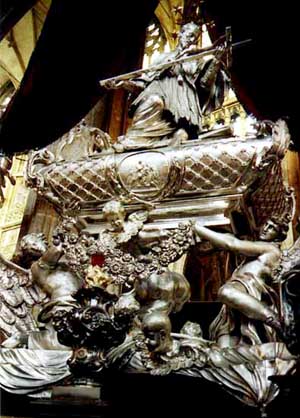
The tomb of St. Nepomucene, Patron Saint of Prague, in St. Vitus Cathedral, below
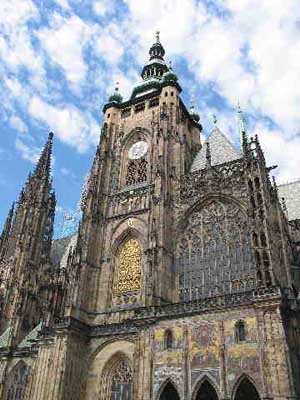 |
Soon after his death, veneration of the martyr began. Such veneration would grow until he would become the most popular Saint of the region. The House of Austria would make every effort for his canonization. After due demonstration of his sanctity was given, he finally reached the glory of the altars in 1729, four centuries after his death.
When we compare the history of the expansion of the heresy of John Hus with that of Luther's Protestantism, we see that they began in a similar way. There was a general movement of deterioration that generated the heresy of Hus. The King was influenced by it, and this resulted in the death of St. John Nepomucene.
But, there are also many differences regarding this environment and the one that generated Protestantism. In Bohemia there was a Saint who resisted; there was a King who, even though he fell, was shaken by his crime. There were masses so enthused with the Saint that the King feared a popular revolt. He had to commit the crime at night or else the people would have prevented it. Then when the Saint was drowned, a miracle took place.
In the environment that generated Protestantism, there was no longer a general resistance to the deterioration; there was no popular indignation against the heresy. Even when there were martyrs, there were no great public miracles like the one we saw with St. John Nepomucene. Everything gives the impression that the supernatural was less present.
How can such a difference be explained? One could argue that ordinarily the greater the need, the more extraordinary the favors Divine Providence should give. The heresy of Luther had a much stronger power of dissemination than the heresy of Hus. Why was the latter heresy smashed, and the former spread? Protestantism was the beginning of a much greater tragedy for the Church. It was the expansion of the Religious Revolution throughout the world. Why, then, didn't Our Lady assist the Church with similar great miracles on this occasion?
After the Revolution was born, it seems that this unremitting rule has applied: Miracles and supernatural manifestations appear less and less frequently, and there are fewer and fewer persons touched by great saints. One has the impression of a dusk setting in, of a loss of strength and vigor of the Church. On the contrary, the enemies of the Church seem animated by a youthful vigor. How can such a thing be explained?
Does it mean that Divine Providence loves the Catholic Church less? Does God no longer hate evil persons as much as before? No, of course these hypotheses are not true.
For one who considers things from the perspective of the Theology of History, the explanation is quite simple. If the Catholics at the time of Protestantism had remained faithful and loved the Catholic Faith as they should have, the consequences would have been different. One third of Europe became Protestant. If the two-thirds that remained Catholic had been faithful and good Catholics, the Protestant third would not have achieved the influence it did. If the Catholics had been what they should have been, the power of Protestantism would have been cut, as was the heresy of John Hus.
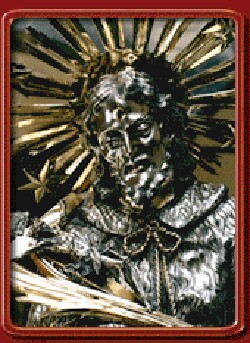
A statue of the Saint made for the House of Eltz. Every first born carries the name John Nepomucene |
Most of the Catholics of that time, however, were lukewarm and weak. To show its disapproval of them, Divine Providence retracted its supernatural manifestations and permitted the heresy to gain force. Following the same process, God gradually drew back His special graces right up until the present moment when we face this paradox: truth and goodness always seem to be weak, and error and evil always strong. This is a manifestation of the discontent of Divine Providence with the lukewarmness and lack of valor of Catholics.
You can imagine, for example, the city of Paris, with its progressivist Archbishop, Cardinal Marty, with its progressivist clergy, with its revolutionary people, with the swarms of tourists who go there seeking moral corruption. The Catholic Faith is so weak in the people of Paris - even though there are still good Catholics there - that it could almost be called inconsequential.
Do you think that if the people of Paris would see the body of a Saint floating on the waters of the Seine River, they would convert, change their immoral habits, close their nightclubs, cabarets, and other places of corruption? I don't think so. I think that a very small number of people would be impressed. The general public would be waiting for some "scientific" explanation for that floating body so that the topic could die.
You can ask me what this means? I respond that this situation proves that God needs to intervene, make an exemplary chastisement of the world, and rebuild a new Christendom, the Reign of the Immaculate Heart of Mary predicted at Fatima. This situation cannot last very long.
These are some considerations suggested by the marvelous life and death of St. John Nepomucene.


  | | Prof. Plinio Corrêa de Oliveira | |
The Saint of the Day features highlights from the lives of saints based on comments made by the late Prof. Plinio Corrêa de Oliveira. Following the example of St. John Bosco who used to make similar talks for the boys of his College, each evening it was Prof. Plinio's custom to make a short commentary on the lives of the next day's saint in a meeting for youth in order to encourage them in the practice of virtue and love for the Catholic Church. TIA thought that its readers could profit from these valuable commentaries.
The texts of both the biographical data and the comments come from personal notes taken by Atila S. Guimarães from 1964 to 1995. Given the fact that the source is a personal notebook, it is possible that at times the biographic notes transcribed here will not rigorously follow the original text read by Prof. Plinio. The commentaries have also been adapted and translated for TIA's site.
|
Saint of the Day | Home | Books | CDs | Search | Contact Us | Donate

© 2002- Tradition in Action, Inc. All Rights Reserved
|
 |

|